Nuclear doctrines updated by three great powers
I have studied this topic – nuclear weapons and nuclear doctrines – in the “basic text” of my website: Status of great powers / Key drivers of military capabilities and Present great powers.
During last five years, there have been many interesting and rapid changes and development trajectories regarding both weapons and doctrines of great powers.
General situation in the triangle game
During last few years in the US, there have been published reports dealing with ”US Strategy and
Force Posture for an Era of Nuclear Tripolarity”. The term “nuclear tripolarity” describes a world in which China has joined the United States and Russia as a leading nuclear power. As China modernizes its existing nuclear forces and deploys new weapons, it is on track to roughly double its deployed nuclear arsenal in the next few years—from approximately 400 to 700 deliverable warheads. The US Department of Defense projects that China will go further, expanding its arsenal to at least 1,500 warheads by 2035.1 At those force levels, China’s arsenal would be comparable (in parity) to US and Russian deployed nuclear forces, currently capped at 1,550 by the New START Treaty.
The strategic dynamics of a tripolar nuclear world are worrisome. If China’s nuclear expansion and modernization continue as expected, the US nuclear arsenal will also need to grow to satisfy current mission requirements. This in turn will lead China and Russia to worry about the vulnerability of their own arsenals, likely triggering additional arms buildups. On the other hand, increasing and deepening Sino-Russian cooperation makes these “nuclear relations” even more complicated. Understood in this light, the United States must find a balance that addresses real challenges to critical nuclear deterrence missions yet avoids (if possible) actions that will trigger a costly and counterproductive arms race.
Nine countries possess nuclear weapons: the United States, Russia, France, China, the United Kingdom, Pakistan, India, Israel, and North Korea. In total, the global nuclear stockpile is close to 13,000 weapons. While that number is lower than it was during the Cold War—when there were roughly 60,000 weapons worldwide—it does not alter the fundamental threat to humanity these weapons represent.
Estimated number of strategic nuclear weapons in 2024
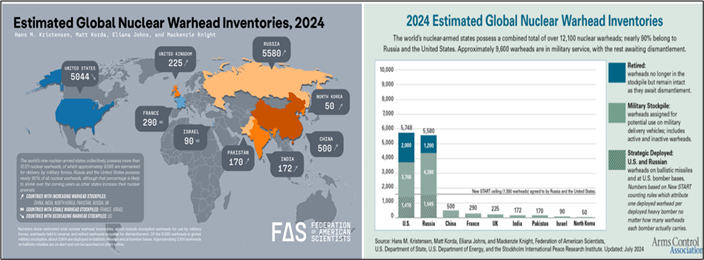
The US and Russia, which are in approx. parity with 1600 deployed strategic warheads, are yet by far two biggest nuclear powers but China is rapidly achieving them, estimated time for “three-party parity” is 2035.
Non-strategical (tactical) nuclear weapons
The United States and Russia still actively deploy tactical nuclear weapons arsenals, which are not regulated by treaty, unlike strategic nuclear weapons. The term “tactical” implies shorter-range, less destructive and more “useable” weapons intended for striking battlefield targets and forward bases in sparsely or unpopulated areas, not wiping out cities, factories and power plants across the globe.
However, any nuclear weapon used any time is a strategic game-changer. US and Russian arms control treaties define non-strategic nuclear weapons as those with a strike range inferior to 5500 km but regional rivals like China, India and Pakistan consider their non-intercontinental range nuclear weapons to be strategic anyway.
Regarding the non-strategic (tactical) nuclear weapons, Russia is by far the biggest power having over 2000 warheads, while the US holding some 200 tactical nukes.
The US non-strategic arsenal is made up of roughly 230 B61 nuclear gravity bombs droppable by jet fighters. 100 to 150 B61s are forward-deployed for use by NATO allies to form a kind of collective-responsibility pact. The Trump administration cited Russia’s development of sophisticated non-strategic weapons as cause to reintroduce less powerful W76-2 nuclear warheads onto Navy submarine-launched ballistic missiles.
In addition to the nuclear strategic triad, the United States maintains a fleet of F-15E Strike Eagle dual-capable aircraft (DCA), which are able to deliver conventional munitions or B61-3/4/10 nuclear bombs. DCA aircraft are available to support the NATO in combined-theater nuclear operations and are also forward deployed in Europe.
The US is incorporating a nuclear capability into the F-35 as a replacement for the current aging F-15E force. Plans for initial fielding of the nuclear-capable F-35 is 2025. Several NATO allies also provide DCA capable of delivering US forward-deployed nuclear weapons. The forward presence of dual-capable aircraft contributes to the deterrence of potential adversaries and the assurance of allies. If necessary, the United States has the ability to deploy DCA and nuclear weapons to other regions
Around 180 American B61 nuclear bombs are currently stationed in Europe, in Germany up to 20 at the Büchel air base in the Eifel. The US also has nuclear weapons on bases in the Netherlands, Belgium, Italy and Turkey, while France and the UK also have their own nuclear arsenals.
Russia’s non-strategic arsenal is estimated to amount up to 2000, from which nearly half (est. 930 warheads) are estimated to belong to the Russian Navy, used both from surface combatants (Kalibr, Oniks and Zircon missiles) and Yase-class submarines. The Russian Navy also reportedly still maintains nuclear torpedoes, depth charges, and anti-submarine rockets.
Russia maintains est. 300 nuclear warheads for surface-to-air missiles for S-300, S-400 and S-500 long-range air defense systems—likely for ballistic missile defense contingencies. The Russian Army is estimated to possess over 100 nuclear warheads for its missile batteries. Iskander-M tactical ballistic missile system can swap its regular warhead for up to a 50-kiloton nuke.
Non-Strategic Bombers. More of Russia’s non-strategic nuclear firepower comes in the form of 500-600 air-launched weapons carried by Su-34 and older Su-24M attack jets and longer-range Tu-22M supersonic bombers, which can carry dual-capable Kh-32 supersonic anti-ship and land-attack missiles. Russia has also developed a unique air-launched Kinzhal hypersonic ballistic missile with a 2000 km range. This is currently deployed by MiG-31K interceptors and can also be carried by the Tu-22M3M bombers. In the future, Moscow is expected to employ Su-57 stealth fighters in a nuclear strike role too.
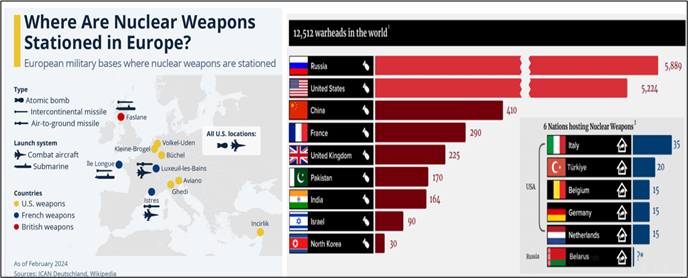
In general, it can be stated that at least the following important features can be found in this nuclear sphere:
- development of hypersonic carriers; both in China and Russia, the US is falling further and further behind
- strengthening of nuclear triad in China and Russia, the silo-based American missile systems are about 60+ years old and implementation of the reform program regarding submarine-based weapon systems is lagging far behind schedule
- all great powers have updated and sharpened their nuclear doctrine
- in strategic air defense, particularly Russia has advanced significantly
- in ASAT and EW technology both China and Russia have advanced significantly
- China and Russia have expanded, enhanced and intensified military cooperation very significantly during last five years
The US
On October 27, 2022, the Biden administration released the unclassified version of its 2022 Nuclear Posture Review (NPR). The document states that nuclear weapons provide a unique deterrent that no other element of US military power can replace and that a safe, secure and effective nuclear deterrent undergirds all US national defense priorities. The NPR supports retention of a triad and continued investments in all existing major nuclear modernization programs including land-based, sea-based, air-based, command and control and some supplemental capabilities.
However, it also states that “deterrence alone will not reduce nuclear dangers.” Accordingly, the NPR puts a “renewed emphasis” on arms control, nuclear non-proliferation and risk reduction, policies that complement and mutually reinforce US nuclear deterrence aims. The NPR identifies mutual, verifiable nuclear arms control as the most “effective, durable and responsible path” to reduce the role of nuclear weapons in US strategy and prevent nuclear use. Here below the key issues of NPR 2022:
Defining the “Role and Purpose of Nuclear Weapons”: The NPR affirms three roles for US nuclear weapons: 1) to deter aggression, 2) to assure allies and partners and 3) to achieve US objectives if deterrence fails.
Rejects No First Use and Sole Purpose: NPR concluded that adopting a “No First Use or Sole Purpose” policy would result in an “unacceptable level of risk” in light of adversaries’ non-nuclear capabilities which could inflict “strategic level damage” to the United States and its allies and partners.
Circumstances for Nuclear Use: The United States would consider using nuclear weapons only in “extreme circumstances” to defend the vital interests of the United States or its allies and partners.
Two Peer Nuclear Adversaries: The NPR states that the United States is entering an unprecedented phase of facing two major nuclear powers as strategic competitors and potential adversaries, creating “new stresses on stability and new challenges for deterrence, assurance, arms control, and risk reduction.” While Russia remains the most capable and diverse nuclear rival, China’s increasing capability is identified as a threat to the United States and allies.
North Korea: The NPR also acknowledges the “persistent and growing danger” posed by North Korea’s weapons of mass destruction and clearly states the dire consequences it would face in the event of nuclear weapons use.
Iran: The NPR states that “Iran does not today possess a nuclear weapon and we currently believe it is not pursuing one,” but expressed concern over steps being taken by Iran that were previously constrained by the Iran nuclear deal.
Extended Deterrence Commitments: The NPR continues a longstanding U.S. commitment to allies and partners to tailor extended deterrence and assurance policies in response to regional security environments.
Nuclear deterrence is the bedrock of US national security, serving as the backstop and foundation of US national defense, the defense of US allies since 1945 and underwrites every US military operation. The US nuclear deterrent is comprised of nuclear weapons and delivery systems, nuclear command, control, and communications (NC3) and the people and infrastructure that support it all. While US nuclear weapons have not been employed since World War II, the United States uses its nuclear deterrent every day to maintain peace around the globe.
The 2022 NPR announces the following declaratory policy: “As long as nuclear weapons exist, the fundamental role of US nuclear weapons is to deter nuclear attack on the United States, our allies, and partners. The US would only consider the use of nuclear weapons in extreme circumstances to defend the vital interests of the United States or its allies and partners. Although the fundamental role of US nuclear weapons is to deter nuclear attack, more broadly they deter all forms of strategic attack, assure allies and partners and allow US to achieve Presidential objectives if deterrence fails.
Any adversary use of nuclear weapons would fundamentally alter the nature of a conflict. We must therefore be able to deter both large-scale and limited nuclear attacks from a range of adversaries. The capability to deter limited nuclear attacks is critical given that some competitors have developed strategies for warfare that may rely on the threat or actual employment of nuclear weapons in order to terminate a conflict on advantageous terms.
Some allies and partners are particularly vulnerable to attacks with non-nuclear means that could produce devastating effects. Given that the U.S. global alliance network is a military center of gravity, the United States will continue to field flexible nuclear capabilities and maintain country-specific approaches that reflect our best understanding of adversary decision-making and perceptions.
As General Paul Selva, USAF (Ret.), Former Vice Chairman of the Joint Chiefs of Staff has stated:
“Our nuclear deterrent is nearing a crossroads. To date, we have preserved this deterrent by extending the lifespan of legacy nuclear forces and infrastructure—in many cases for decades beyond what was originally intended. But these systems will not remain viable indefinitely. In fact, we are now at a point where we must concurrently modernize the entire nuclear triad and the infrastructure that enables its effectiveness.”

According to the New York Times, August 20, 2024, President Biden approved in March a highly classified nuclear strategic plan for the United States that, for the first time, reorients America’s deterrent strategy to focus on China’s rapid expansion in its nuclear arsenal. The shift comes as the Pentagon believes China’s stockpiles will rival the size and diversity of the United States’ and Russia’s over the next decade.
The White House never announced that Biden had approved the revised strategy, called the “Nuclear Employment Guidance”, which also newly seeks to prepare the United States for possible coordinated nuclear challenges from China, Russia and North Korea. The document, updated every four years or so, is so highly classified that there are no electronic copies, only a small number of hard copies distributed to a few national security officials and Pentagon commanders. But in recent speeches, two senior administration officials were allowed to allude to the change — in carefully constrained, single sentences — ahead of a more detailed, unclassified notification to Congress expected before Mr. Biden leaves office.
In June, the National Security Council’s senior director for arms control and nonproliferation, Pranay Vaddi, also referred to the document, the first to examine in detail whether the United States is prepared to respond to nuclear crises that break out simultaneously or sequentially, with a combination of nuclear and nonnuclear weapons. The new strategy, Mr. Vaddi said, emphasizes “the need to deter Russia, the PRC and North Korea simultaneously”, using the acronym for the People’s Republic of China.
In the past, the likelihood that American adversaries could coordinate nuclear threats to outmaneuver the American nuclear arsenal seemed remote. But the emerging partnership between Russia and China and the conventional arms North Korea and Iran are providing to Russia for the war in Ukraine have fundamentally changed Washington’s thinking. The new document is a stark reminder that whoever is sworn in next January 20, will confront a changed and far more volatile nuclear landscape than the one that existed just three years ago.
The second big change arises from China’s nuclear ambitions. The country’s nuclear expansion is running at an even faster pace than American intelligence officials anticipated two years ago, driven by President Xi Jinping’s determination to scrap the decades-long strategy of maintaining a “minimum deterrent” to reach or exceed the size of Washington’s and Moscow’s arsenals. China’s nuclear complex is now the fastest growing in the world.
The Biden strategy sharpens that focus to reflect the Pentagon’s estimates that China’s nuclear force would expand to 1,000 by 2030 and 1,500 by 2035, roughly the numbers that the United States and Russia now deploy. In fact, Beijing now appears ahead of that schedule, officials say, and has begun loading nuclear missiles into new silo fields that were spotted by commercial satellites three years ago.
There is another concern about Beijing: It has now halted a short-lived conversation with the United States about improving nuclear safety and security — for example, by agreeing to warn each other of impending missile tests, or setting up hotlines or other means of communication to assure that incidents or accidents do not escalate into nuclear encounters.
The US Navy’s Columbia-class nuclear ballistic missile submarine (SSBN) program is perilously behind schedule, raising concerns about the service’s ability to replace aging Ohio-class SSBNs on time to maintain nuclear deterrence amid rising tensions with China. Last month, the US Government Accountability Office (GAO) released a report saying that the Columbia-class program faces significant challenges, including delays, cost overruns and performance risks that jeopardize its timeline.
The first Columbia SSBN was initially planned for delivery by April 2027 but is now expected between October 2028 and February 2029, potentially affecting its planned availability for operations in 2030, according to the GAO report. The report mentions that without better oversight and revised cost estimates, the US Navy may face operational gaps in its nuclear deterrence strategy, increasing reliance on aging Ohio-class SSBNs whose service lives may now need risky extensions.
Another big problem is emerging with the aging of silo-based Minuteman III system whose renovation will be a massive and multitrillion-dollar costly project.

For further reading:
National Defense Strategy 2022, Nuclear Posture Review 2022, Missile Defense Review 2022
The US Department of Defense
US Strategy and Force Posture for an Era of Nuclear Tripolarity
Atlantic Council, April 2023
The Heritage Foundation 2024, Special Report no. 287, July 30, 2024
China
BEIJING has recently reiterated and confirmed that “China’s nuclear policy is very stable, consistent and predictable. We strictly follow a nuclear policy of no first use of nuclear weapons and pursue a nuclear strategy of self-defense,” said Senior Colonel Zhang Xiaogang, a spokesperson for China’s Ministry of National Defense, at a press conference on September 26.
The spokesperson made the remarks when responding to a media inquiry regarding China’s launch of an intercontinental ballistic missile into the Pacific Ocean on September 25. The spokesperson pointed out that China strictly follows a nuclear policy of no first use of nuclear weapons and pursues a nuclear strategy of self-defense. China does not seek any arms race.
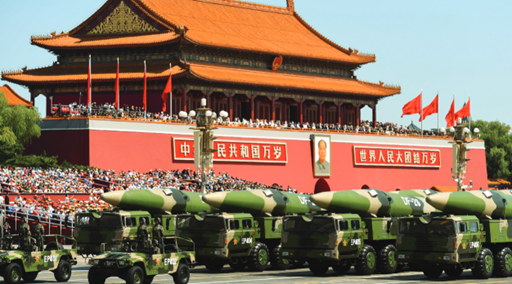
Role of the Nuclear Weapons in China’s Military Strategy
Nuclear weapons have been playing an important role in China’s national and military strategy. However, they have not played a key role. China’s nuclear doctrine has gradually experienced the process change from a counter-nuclear blackmail strategy to a minimum deterrence strategy. Now the most important task of the People’s Liberation Army (PLA) is to win partial wars under the situation of high technology. Conventional forces are still the major implements used to win
these kinds of wars. Nuclear weapons’ major task of China is to deter the enemy from launching an initial nuclear attack against China.
Structure of China’s current official nuclear doctrine
Similar to the nuclear doctrines of other nuclear-weapon states, China’s doctrine has composed five policies: policy of declaration, nuclear development, nuclear deployment, nuclear employment, and nuclear disarmament. Because China has a different strategic culture and is in a different situation, its nuclear doctrine has the following characteristics.
Firstly, the declared policy of China’s nuclear doctrine is no-first use of nuclear weapons and self-defense. From the start China has made it very clear that it will not use nuclear weapons first at any time and under any circumstance. No-first use of nuclear weapons has had strategic significance, and is based on deep consideration. China believes that the final results of wars are decided by people instead of advanced weapons and WMD. The most significant foundation for China’s national defense is the concept of People’s War.
Secondly, China’s policy of nuclear development is the building of a lean and effective strategic nuclear force. Chinese national security has mainly depended on a foreign policy of peace and the integrated power of People’s War. Nuclear force is one of the most important pillars and parts of China’s armed forces but not the foundation stone and the core of China’s national defense forces. In order to reach the goal of deterrence, China must develop a strategic nuclear force with the capability of basic means of retaliation.
Thirdly, China’s policy of nuclear weapons deployment is to maintain a second-strike capability. China has focused on maintaining this capability in its nuclear weapons deployment–That is the capability of nuclear retaliation. China has never deployed nuclear weapons outside of it. In 1979, the Central Committee of Chinese Communist Party made the decision to build the “Great Wall” Project, the purpose of which was to make China’s land-based strategic nuclear force have the capability to survival and retaliate after suffering from a first nuclear strike by other countries. Strategic nuclear submarines are also an important capability of second strike; they are beneficial for improving strategic stability between China and other nuclear powers.
Fourthly, China’s policy of nuclear employment is self-defense and retaliation.
Fifthly, China’s policy of nuclear disarmament regards the complete prohibition and thorough destruction of nuclear weapons as the final goal in nuclear issues.
China’s ambitious nuclear project – reach parity with other two great power
As stated in numerous American reports, cited above, during the last decade, China has shown remarkable characteristics of great power, starting a intense development of nuclear weapons and weapons systems, with the aim to get the parity of two other great powers – the US and Russia. The current number of deployed nuclear weapons is approx. 400 – 500 units covering the whole nuclear triad, with the aim of 1000 units in 2030 and 1500 (parity) in 2035.
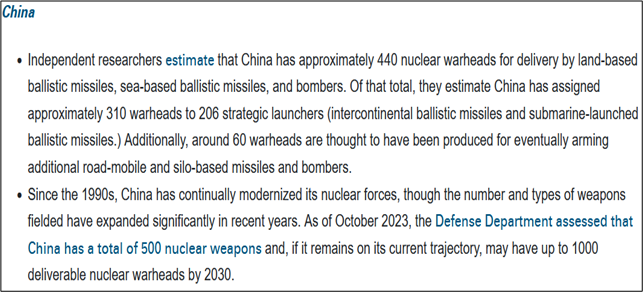
Further reading of this topic available here:
Carnegie Endowment for International Peace, July 17, 2024, an article by Tong Zhao
Discerning the Drivers of China’s Nuclear Force Development: Models, Indicators, and Data
National Defense University, July 26, 2024, report by David C. Logan and Phillip C. Saunders
Understanding China’s Approach to Nuclear Deterrence
The Diplomat, August 2, 2024; an article by Alex Alfirraz Scheers
Russia
On September 25, the permanent conference on nuclear deterrence is a working body of the Security Council of the Russian Federation that makes decisions regarding the country’s nuclear policy.
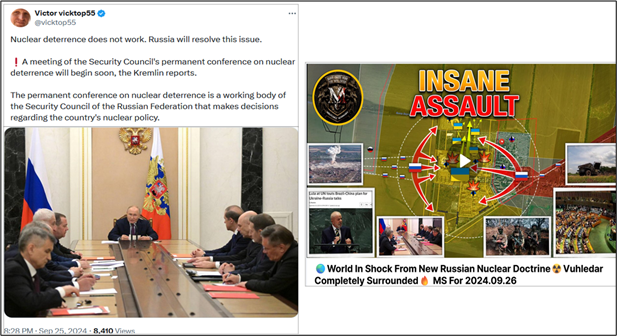
🌏World In Shock From New Russian Nuclear Doctrine☢️Vuhledar Completely Surrounded🔥 MS For 2024.09.26
September 25, Russian President Vladimir Putin has laid out the planned changes that are to be introduced in Russia’s nuclear doctrine. The document, known formally as Basic Principles of State Policy on Nuclear Deterrence, lays the groundwork for the use of nuclear weapons, defining nuclear response as an extreme measure to protect the country’s sovereignty.
However, recent geopolitical developments and emerging military threats and risks necessitated the review of the document. During a meeting of the Russian Security Council on the issue of nuclear deterrence, Putin outlined the basic parameters of the updated document. The new version has already been drafted, but the president is yet to approve it.
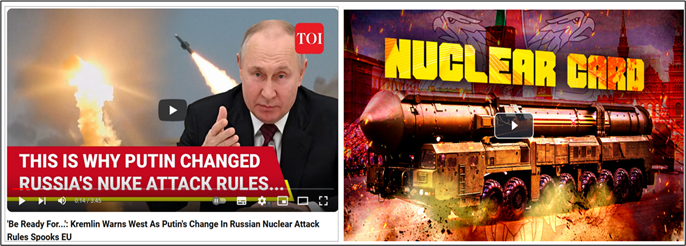
‘Be Ready For…’: Kremlin Warns West As Putin’s Change In Russian Nuclear Attack Rules Spooks EU , Times Of India, September 26, 2024
Putin Trumps Kiev’s Dreams Of Escalation With Nuclear Card
South Front, September 27, 2024
Russia has revised the principles of using nuclear weapons and now “the category of states and military alliances against which nuclear deterrence is carried out has been expanded and the list of military threats has been supplemented.”
In the updated version of the document, “aggression against Russia by any non-nuclear state, but with the participation or support of a nuclear state, is proposed to be considered as their joint attack on the Russian Federation.” That is, both Kyiv and Washington are responsible for the strike on Ukraine with American missiles. And it is, accordingly, legal to strike both with nuclear weapons.
The conditions for Russia’s transition to the use of nuclear weapons have also changed. Now “Russia is considering such a possibility upon receiving reliable information about a massive launch of air and space attack weapons and their crossing our state border. It means strategic and tactical aircraft, cruise missiles, drones, hypersonic and other aircraft.”
That is, a strike by non-nuclear American or British missiles is still a de facto pretext for a nuclear strike on Kyiv or Washington. The same applies to a strike on Belarus. Putin specifically emphasized that all this applies to conventional weapons, if they try to strike strategic facilities – “including if the enemy, using conventional weapons, creates a critical threat to our sovereignty”.
Putin emphasized that “We reserve the right to use nuclear weapons in the event of aggression against Russia and Belarus as a member of the Union State. All these issues have been agreed upon with the Belarusian side, with the President of Belarus. Including if the enemy, using conventional weapons, creates a critical threat to our sovereignty. All clarifications are deeply verified and proportionate to modern military threats and risks in relation to the Russian Federation.”
TASS gathered key facts on the subject in the following way:
Changes in the doctrine
- The revised document has a broader list of countries and military alliances that are subject to nuclear deterrence.
- It adds more entries in the list of military threats, whose neutralization requires nuclear deterrence.
- Aggression against Russia by a non-nuclear country, but with the participation or support of a nuclear country, was proposed to be viewed as their joint attack on Russia.
- Reliable information about a massive takeoff of strategic or tactical planes towards Russia, or the launch of cruise missiles, drones, hypersonic weapons towards its territory may be interpreted as a sufficient reason for a nuclear response by Moscow.
- Russia reserves the right to use nuclear weapons in case of aggression against itself and its ally Belarus.
- Critical threat to Russian sovereignty with conventional weapons will be sufficient for a nuclear response.
Russia’s stance
- Russia has a responsible attitude to the issue of nuclear weapons and seeks to prevent their proliferation across the globe.
- The nuclear triad remains an important safeguard for Russia’s security and an instrument for maintaining global balance.
- The current edition of the nuclear doctrine was approved in June 2020, replacing a previous similar document that remained in force for about a decade.
- The doctrine is being adjusted on the basis of analytical work, carried out by specialists from the Defense Ministry, the Foreign Ministry, the Security Council Apparatus and other governmental agencies over the past year.
- All adjustments are calculated, calibrated and proportionate to present-day military threats and challenges that Russia has to face.
Putin did not elaborate on, when changes to Russia’s nuclear doctrine will take effect. Senior Russian officials, including Deputy Foreign Minister Sergey Ryabkov and Kremlin spokesman Dmitry Peskov have been discussing potential changes to the doctrine in recent months. In late August, Foreign Minister Sergey Lavrov said that the document was “being reviewed.”
The Russian leader has long demonstrated a rather reserved position on the issue of nuclear weapons. Back in June, he expressed hope that “it will never come” to a nuclear exchange between Moscow and the West. Moscow “has no reasons to even think about” using nuclear weapons, he said at the time, speaking at the St Petersburg International Economic Forum. Later that month, the president also stated that Russia did not need to launch a pre-emptive nuclear strike, since “the enemy is guaranteed to be destroyed in a retaliatory strike.” He did not, however, rule out changes to the doctrine at the time.
In fact, the new Russian nuclear doctrine paves the way for fundamental changes to the global security system. The West seems to be surprised. The western warmongers start crying that Putin is simply bluffing and there can be no threat of nuclear escalation. Nuclear weapons are yet to enter the battle.
For further reading:
http://en.kremlin.ru/events/president/news/75182
Kremlin says changes to Russia’s nuclear policy are a signal to the West
By Reuters, September 27, 2024
Why is Russia changing its nuclear doctrine amid the Ukraine war?
Al Jazeera, September 3, 2024
Here’s why Putin decided to send a nuclear message to Washington
The Intel Drop, September 30, 2024
How Serious a Threat Is Russia’s New Nuclear Doctrine?
The Carnegie Endowment, by Alexander Gabuev , Published on October 3, 2024
Closing words
The relations between great powers are getting more and more “dramatic”, the escalation in the Middle East is on the verge of full-scale war, in Ukraine the Ukrainian Forces are near the total collapse, the NATO & the EU are facing the beginning of severe disintegration process and in the US the political stakes are at all-time high just before the presidential elections.
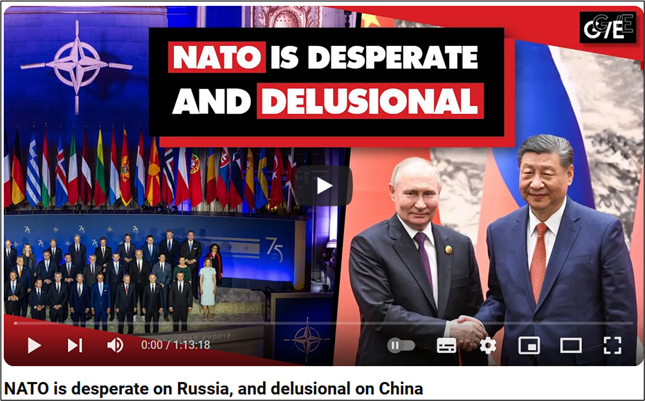
NATO is desperate on Russia, and delusional on China
Geopolitical Economy Report, October 1, 2024, by Radhika Desai, Michael Hudson and Glen Diesen


